Each year sailboats cruising in the Tuamotus get into trouble at anchor: they get trapped on lee shores after a shift in the wind direction and foul their anchor and/or chain in coral. Having just a short piece of free chain left while pitching madly is a dangerous situation and the results are stressful maneuvers to get the anchor back up, bent bow rollers and ruined or even ripped out windlasses. Of course the fragile coral structures get badly damaged with each of these messed up maneuvers. Isn’t an anchorage with colorful coral and fishies much nicer than a dead rubble field?
It is easy to avoid damage to the coral and your boat if you
- anchor in conditions with good visibility (don’t drop your anchor blindly)
- anchor in shallow water: 1. you can see the bottom clearly, 2. there are usually fewer coral heads on the sandy shelves and 3. you require less chain
- try to find a big, sandy spot to drop your hook
- float the chain so that the boat can swing around in shifting winds without getting the chain caught in coral heads
- keep an eye on the weather forecast and move to a safe anchorage before the wind shifts
Floating the chain is a simple procedure. You just need
- 2 medium-sized fenders or pearl-farm buoys
- 2 carabiners that fit into your chain (8mm for 10mm chain)
- Drop the anchor in the middle of the biggest sandy spot you can find
- Pay out chain while reversing gently
- Look around at the surrounding coral heads and estimate your swinging radius. Hook in the first float before the chain could touch any of them.
- Pay out some more chain and set the anchor gently pulling in reverse.
- If the scope is still not sufficient, a second float can be added followed by more chain.
Some additional notes:
Anchors: On Pitufa we use a German Bügelanker (similar to Rocna) as our main anchor. We love it as it sets very quickly, even with little scope. We lose only 20-50cm until it’s dug in. We observed other cruisers struggling badly when anchoring around coral because their anchors (mainly CQRs, also Delta at one or two occasions) need to plow quite far until they’re finally set. By then the end of the sandy patch might have been reached… So, take your anchor’s properties/requirements into consideration (e.g. start the anchoring process further windward on the sandy patch). Or even better: don’t set out with a bad anchor right from the start.
Depth: Many cruisers are afraid of anchoring in shallow areas (particularly when the area is uncharted). Also Pitufa’s crew preferred to anchor with plenty of water under the keel before gaining experience in the Tuamotus. On sandy shelves we love to anchor in 2.5-4 meters (often those areas are free of coral heads). When there are no such shelves we anchor in 4-8 meters and float the chain (25-30 meters) with 1 or 2 floats. In deeper water (10 meters or more) the floating procedure becomes much trickier: 1. placing the anchor properly on the sandy patch as well as deciding when to start buoying becomes a game of chance (light refraction is tricky), 2. the weight of longer chain is too much for the floats (you need bigger ones or you can tie two together).
Enjoy the Tuamotus!
Download 1-page leaflet (PDF):


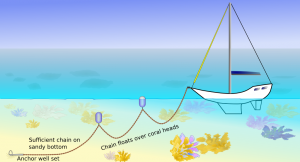
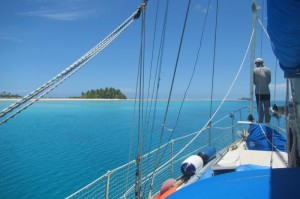
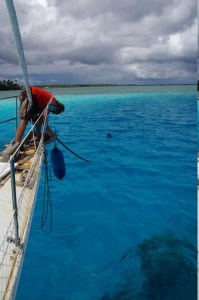
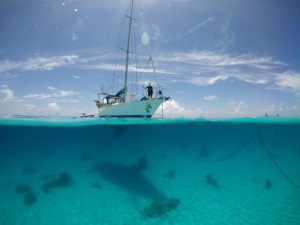
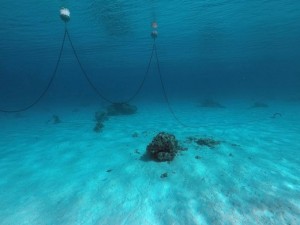
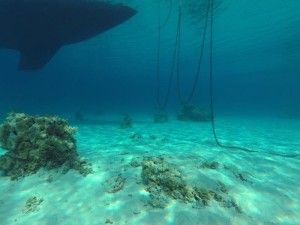





3 comments
Norbert and Rosi says:
May 15, 2017 at 4:22 pm (UTC 0)
Hi guys!
We are also on a tour again. If you depart on a true course of 002.92° and follow it for 3605 NM you will arrive at our present location (Cambria, CA). We are looking out of the window onto the ocean and imagining where we would find you if we followed a straight line.
It is so good to read that you are both doing well and that you are enjoying the south pacific. Those flight to and from Austria must have been very strenuous – consider that we are already complaining about the 11 hour flight to San Francisco:-)
Have a safe commute over into the Tuamotus in a couple of weeks!
Greetings from California
Norbert and Rosi
Dov says:
November 26, 2017 at 2:22 pm (UTC 0)
Very interesting, but I don’t understand 2 features. First, by using the floats, your anchor chain is at the wrong angle to the anchor, so thus the benefits of sufficient scope has been negated.
Second, if the wind blows hard, the chain will stretch out, the floats won’t float, and thus you may snag the coral. Can you explain a little further how this works?
We have a Rocna, and agree 100% with you about cruisers still using CQR’s and Delta’s and similar. They are a menace to the rest of us!
Christian says:
November 26, 2017 at 6:44 pm (UTC 0)
Hi,
thanks for your comment. You have a point in both cases.
Regarding the angle: a floated chain behaves similar to a chain followed by rope. So it is important to find a sandy spot that’s big enough to have plenty of chain on the bottom before the first float. Once the wind picks up (which is when the angle matters) and the boat pulls on the chain, the floats get submerged and the angle gets better (again as with rope after chain).
Secondly: The risk of tangling the chain on bommies is highest when the boat swings around in shifting winds and the chain on the bottom is dragged around like a loop or lasso. When you use floats the chain remains over coral in light winds. Once the wind picks up and the chain stretches it usually remains above bommies and if it’s lowered enough to touch one it’s still unlikely to get trapped. At least it’s never happened to us during the past few years.